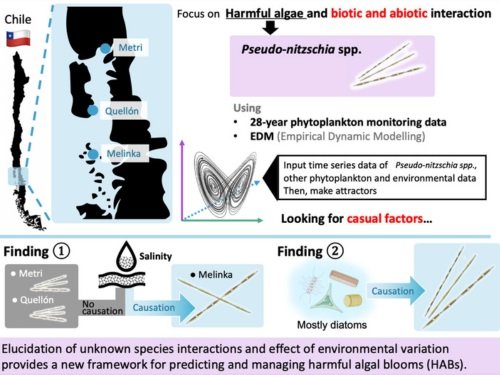UK.- Scientists at the National Oceanography Centre (NOC) are developing an innovative new sensor and associated analytical techniques for monitoring and classifying phytoplankton that can cause harmful algal blooms (HABs). The two-year project is one of 12 to receive a total of £5.1 million of UKRI funding, focusing on UK aquaculture research.
In the aquaculture sector – the farming of fish, crustaceans, molluscs, aquatic plants, algae, and other marine organisms – the loss of stocks or closure of sites due to the presence of HABs can cause significant financial loss. Increasingly detailed and up-to-date knowledge about HAB formation at aquaculture sites will enable rapid and informed decisions about sampling and harvesting, delivering direct economic benefits.
The PhytoMOPS (Phytoplankton Morphology and Optical Properties Sensor) device will monitor the dynamics of algal phytoplankton species to help improve the productivity and availability of feedstocks by detecting for the presence of HABs, which impact upon aquaculture sites through light absorption, deoxygenation of the water, and production of biotoxins. The consumption of shellfish which have fed on toxin-producing algae can cause severe adverse human health effects. Existing monitoring techniques take considerable time and resources, slowing decision making and increasing the risk of health and economic impacts.
PhytoMOPS will address shortcomings in existing monitoring techniques by providing low-cost, high resolution independent data. The technology will act as an ‘early warning’ system, detecting HABs as they form, enabling regulatory and statutory bodies to quickly make informed decisions and target their resources more effectively.
How does it work?
The new deployable device will be based upon the autonomous microfluidic chemical analysis platform developed at the NOC. It will operate in situ in the water, providing direct measurements that generate data much faster than manual collection and subsequent microscopy analysis. This robust and rugged platform will usea suite of microfluidic technologies and components – including optics, electronics, pumps, and valves – which have already been successfully deployed for periods of more than a year, at depths greater than 4800 metres, and in the most hostile coastal and ocean environments on the planet.
The PhytoMOPS device will take advantage of a relatively new technique called inertial microfluidics in which particles are manipulated in a small channel using only ‘passive’ forces – those arising from the system’s fluid dynamics – which in turn result from carefully designed combinations of channel geometry and fluid flow rates. This will enable the sorting and identification of algal cells by size and shape, allowing researchers to look at the distribution of cells in an algal bloom, triggering more detailed analysis as required.
Stay Always Informed
Join our communities to instantly receive the most important news, reports, and analysis from the aquaculture industry.
The formation of HABs has caused significant economic damage around the world through the loss of aquaculture stocks, negative impacts upon tourism and recreational facilities, treating related illnesses, and through the costs associated with monitoring and managing blooms. HABs cost an estimated €589 million (£517 million) per year in the EU, and at least $82 million (£59 million) in the US. The UK is responsible for around 15 per cent of the total EU aquaculture production and produces the second largest amount of aquaculture (by volume) in the EU. PhytoMOPS will contribute to a financially robust aquaculture industry with a high level of consumer confidence, which can continue to contribute to and grow the UK economy.
The NOC will engage with a range of partner organisations to deliver PhytoMOPS. The Scottish Association for Marine Science (SAMS) will provide expert advice around the selection of appropriate aquaculture-relevant HAB-forming test species, longer term culturing for test samples, and technical assistance for field trials. The Agri-Food and Biosciences Institute (AFBI), which currently delivers the statutory toxic phytoplankton monitoring programme in Northern Ireland, will provide comparative data, access to models, data records, and analytical facilities. Chelsea Technology Group will provide access to a fluorescence-based algae monitor system to enable side-by-side testing, as well as their engineering expertise.
The project’s Principal Investigator, Dr Allison Schaap, said: “I’m excited to pursue this project which will expand the capabilities of the microfluidic sensor technology that we have developed here at the National Oceanography Centre. It’s a great example of how we can combine engineering, science, theory, and application to provide new tools to address a global problem while adding value to the UK aquaculture sector.”
Source: National Oceanography Centre (NOC)
Editor at the digital magazine AquaHoy. He holds a degree in Aquaculture Biology from the National University of Santa (UNS) and a Master’s degree in Science and Innovation Management from the Polytechnic University of Valencia, with postgraduate diplomas in Business Innovation and Innovation Management. He possesses extensive experience in the aquaculture and fisheries sector, having led the Fisheries Innovation Unit of the National Program for Innovation in Fisheries and Aquaculture (PNIPA). He has served as a senior consultant in technology watch, an innovation project formulator and advisor, and a lecturer at UNS. He is a member of the Peruvian College of Biologists and was recognized by the World Aquaculture Society (WAS) in 2016 for his contribution to aquaculture.



